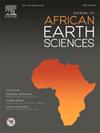Concentrations, distribution, and source appointment of heavy metal/loids in non-clastic sedimentary rocks: a case study of early jurassic chert, northeastern türkiye
IF 2.2
4区 地球科学
Q2 GEOSCIENCES, MULTIDISCIPLINARY
引用次数: 0
Abstract
The Current study used geochemical indicators such as the geo-accumulation index (Igeo), the Enrichment Factor (EF), and the contamination factor (CF) to evaluate the regional distributions and accumulations of various heavy metal/loids (HM; Co, Mo, Pb, Zn, Cu, Ni, As, Cd) in early Jurassic cherts in the Gümüşhane (NE Türkiye). Five stratigraphic section measurement (MS) areas (Tedaş, Alemdar, Akçakale, Tekke, and Pirahmet) and one borehole (Eskibağlar well) were selected for sampling. Major and trace element compositions of the selected 25 samples were measured by inductively coupled plasma optical emission spectrometry (ICP-OES) and inductively coupled plasma mass spectrometry (ICP-MS). Calculated geochemical indexes indicated that Alemdar, Tekke MS, and Eskibağlar well samples were polluted with Pb, Zn, Cu, As, and Cd, Tedaş, Akçakale, and Pirahmet MS samples were polluted with Cd. Pearson's correlation coefficient (PCC) and principal component analysis (PCA) suggested that Zn, Pb, and Cu contaminating the Alemdar, Tekke MS, and Eskibağlar well samples were of ore mineralization origin, As was of terrigenous input, and Cd was probably of diatom origin. PCC and PCA showed that the Cd contaminating the Tedaş, Akçakale, and Pirahmet MS samples was probably of diatom origin, and the other metals found at normal levels in the samples were due to terrigenous input. The Early Jurassic period, which was a rift environment in the Gümüşhane region, is thought to have produced the cherts of the Alemdar, Tekke MS, and Eskibağlar well samples in a graben environment, while the cherts of the Tedaş, Akçakale, and Pirahmet MS were deposited in a horst environment. δU values, Ni/Co, and Vi/(V + Ni) ratios indicated that oxic-anoxic conditions were generally prevalent in the depositional environment, but redox conditions did not affect the abundance and distribution of HMs. These findings provide critical information for assessing heavy metal/loid enrichment and contamination potential not only in clastic sedimentary rocks, river sediments, and soils but also in non-clastic sedimentary rocks.
非碎屑沉积岩中重金属/固体的浓度、分布及来源确定——以甘肃东北部早侏罗世燧石岩为例
目前研究采用地球化学指标,如地质聚集指数(Igeo)、富集因子(EF)和污染因子(CF)来评价各种重金属/固体(HM;石岩中Co, Mo, Pb, Zn, Cu, Ni, As, Cd) (NE trkiye)。选取5个地层剖面测量区(tedaai、Alemdar、akakale、Tekke和Pirahmet)和1口井(Eskibağlar井)进行采样。采用电感耦合等离子体发射光谱法(ICP-OES)和电感耦合等离子体质谱法(ICP-MS)测定了所选样品的主要元素和微量元素组成。计算出的地球化学指标表明,Alemdar、Tekke质谱和Eskibağlar井样中存在Pb、Zn、Cu、As和Cd污染,tedaai、akakale和Pirahmet质谱样品中存在Cd污染。Pearson相关系数(PCC)和主成分分析(PCA)表明,Alemdar、Tekke质谱和Eskibağlar井样中Zn、Pb和Cu为矿化来源,As为陆源输入,Cd可能为硅藻来源。PCC和PCA分析表明,污染tedaai、akakale和Pirahmet质谱样品的Cd可能是硅藻源的,其他正常水平的金属是陆源输入的。早侏罗世g m hane地区为裂谷环境,Alemdar、Tekke MS和Eskibağlar井样形成于地堑环境,而tedaak、akakale和Pirahmet MS的岩样形成于地质体环境。δU值、Ni/Co和Vi/(V + Ni)比值表明,沉积环境普遍存在氧-缺氧条件,但氧化还原条件不影响HMs的丰度和分布。这些发现为评估碎屑沉积岩、河流沉积物和土壤以及非碎屑沉积岩中重金属/样物质的富集和污染潜力提供了重要信息。
本文章由计算机程序翻译,如有差异,请以英文原文为准。
求助全文
约1分钟内获得全文
求助全文
来源期刊

Journal of African Earth Sciences
地学-地球科学综合
CiteScore
4.70
自引率
4.30%
发文量
240
审稿时长
12 months
期刊介绍:
The Journal of African Earth Sciences sees itself as the prime geological journal for all aspects of the Earth Sciences about the African plate. Papers dealing with peripheral areas are welcome if they demonstrate a tight link with Africa.
The Journal publishes high quality, peer-reviewed scientific papers. It is devoted primarily to research papers but short communications relating to new developments of broad interest, reviews and book reviews will also be considered. Papers must have international appeal and should present work of more regional than local significance and dealing with well identified and justified scientific questions. Specialised technical papers, analytical or exploration reports must be avoided. Papers on applied geology should preferably be linked to such core disciplines and must be addressed to a more general geoscientific audience.
 求助内容:
求助内容: 应助结果提醒方式:
应助结果提醒方式:


